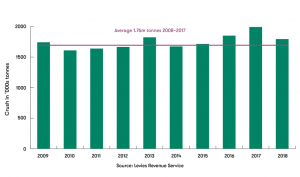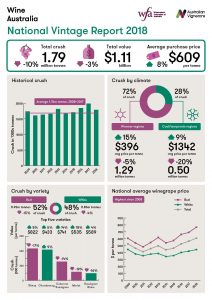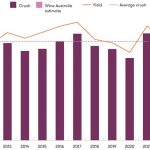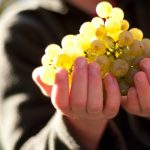Australia’s winegrape crush in 2018 was 1.79 million tonnes, just above the long-term average of 1.76 million tonnes, and the average purchase price for winegrapes increased by eight percent to $609 per tonne, the highest level since 2008.
Wine Australia chief executive officer Andreas Clark welcomed the increase in the average purchase price.
“The increase in grape prices applied to both red and white grapes, with red grape prices increasing by 11% to $768 a tonne while values for white varieties increased, on average, five percent to $444 a tonne,” Clark said.
Winemakers’ Federation of Australia chief executive officer Tony Battaglene said another good vintage was welcomed by winemakers and provided the raw materials for the quality wine required to supply our growing export and domestic demand.
Australian Vignerons chief executive officer Anna Hooper welcomed the increase in price per tonne and said she hopes to see the trend continue in order to ensure the sustainable pricing for winegrapes in the longer term as the recognition of Australia’s wine quality proposition continues to grow.
The divergence between red and white average prices has increased steadily since 2011, driven by strengthening relative demand for red wine.
Despite the higher prices, the total estimated value of the crush decreased by three percent to $1.11 billion, reflecting the ten percent reduction in total crop size from the record 2017 vintage of 1.99 million tonnes.
The crush
The decline in tonnes compared with last year was greatest in percentage terms in the cool/temperate regions, which were down by 20% overall, while the warm irrigated regions (Riverina, Murray Darling–Swan Hill and Riverland) were less affected by the drier spring and summer, with yields down just five percent.
Figure 1 Total winegrape crush in Australia 2009–2018

Clark said that while production of red grape varieties had decreased by 15% on 2017 figures, it had to be remembered that the above average 2017 vintage had seen tonnages increase by 12%, meaning that the 2018 vintage was effectively a return to long-term averages.
The decline in the white variety crush was only four percent compared with 2017, leading to a reduction in the red share from 55% to 52% of the crush, in line with the three year average.
Of the major varieties, Shiraz tonnes decreased by 1%, Cabernet Sauvignon by 14% and Merlot by 19%.
Chardonnay was the only major variety to go against the trend, increasing by nine percent and restoring its share of the white crush to 47% after falling to 42% last year.
The proportion of winery-grown fruit decreased from 33% of the crush in 2017 to 31% in 2018.
Winegrape prices
The calculated average purchase price of $609 per tonne, was up by eight percent on the price of $565 a tonne calculated in 2017.
This figure is the highest since 2008 and above the average price across the past ten years of $508 per tonne.
It is the fourth consecutive vintage where the average purchase price for winegrapes has increased. Since hitting a low in 2011, the overall average grape price has increased by a compound annual rate of six percent over the past seven years. However, the average is still roughly two-thirds of its peak in 2001.
The overall average purchase price of red grapes increased by 11% from $692 to $768 per tonne, while the average price of white grapes increased by five percent from $421 to $444 per tonne. The divergence between red and white average price has increased steadily since 2011, driven by strengthening relative demand for red wine.
Each of the top ten red varieties showed increases, with Shiraz up by eight percent (on top of a 12% increase in 2017), Cabernet Sauvignon up by 14% and Merlot up by 18%. Among the whites, Chardonnay increased by five percent despite a significant increase in tonnes produced, Sauvignon Blanc increased by four percent and Muscat Gordo Blanco increased by three percent. The only white variety to decline in overall average price was Pinot Gris/Grigio (down one percent).
The survey
The National Vintage Report is based on a survey of winemakers conducted in May–June 2018. Responses were received from more than 400 businesses, including all wineries known to crush more than 10,000 tonnes, and they are estimated to account for 85% of all winegrapes crushed in 2018.
*It should be noted that the 2017 figures reported in this report will vary slightly from those reported last year, as they were based on last year’s estimated crush figure and have now been adjusted for the actual Department of Agriculture and Water Resources levies unit recorded figure.





















